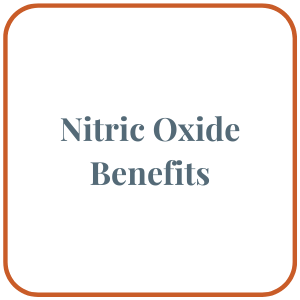Nitric oxide benefits control the ability of the body to relax – improving muscular, cardiac, vascular, brain, and sexual function.
Researchers have discovered nitric oxide (NO) is capable of even more – affecting neurotransmitter release, immunity, metabolic activity, exercise performance, and inflammation, all of which are reviewed below and more.
Deficiencies in nitric oxide are widespread across all groups, made worse with age as our ability to produce nitric oxide declines.
Younger age groups are also experiencing declines in exercise, sexual function, and cardiovascular health as obesity, high-sugar, sedentary lifestyle, and high-processed food diets are the norm, not the exception.
Nitrates from the diet are necessary to support NO production. These are found in leafy green vegetables like spinach. Most Americans consume 71mg of nitrates per day, well below the minimum 360mg+ required to produce ample NO levels (1).
L-arginine is a popular addition to sports performance and vascular health supplements. While supportive of NO, L-arginine depends on enzymes that decrease with age and may not be sufficient on its own to support NO needs.
Nitric Oxide Levels Decline with Age

By age of 40, our natural production of NO may be decreased as much as 50%. By 60 years old, only 15% of capacity remains (2; 3; 4; 5; image from Berkeley Life Professional).
Individuals who carry variants in the MTHFR genes are also prone to deficiencies in nitric oxide. Variants are present in 40% of the population (6).
Needs of nitrates in food or supplements (360mg-1000mg+) repeat daily.
Eating a lot of leafy greens today will not support nitric oxide production tomorrow. Regular intake through diet and/or supplementation is necessary to support the nitrate pathway daily.
Healthy Sources of Nitrates in the Diet
Nitrates are found in the diet, but most individuals are not consuming enough to optimize NO function in the body.
Mustard greens, celery, spinach, beetroot, and cabbages are among the highest sources of natural nitrates.
Others include endive, fennel, kohlrabi, leek, and parsley.
More moderate sources come from broccoli, carrots, cauliflower, cucumber, and pumpkin.
Lower sources still include artichoke, asparagus, broad bean, eggplant, garlic, onion, green bean, mushroom, pea, pepper, potato, summer squash, sweet potato, tomato, and watermelon.
At-home nitric oxide testing and nitric oxide support supplementation are now available to measure and support your levels.
How is Nitric Oxide Made from Nitrates?
It turns out that the health of the mouth, teeth, gums, and stomach is essential for optimal nitric oxide levels in the body.
When we consume nitrates in the diet, they are absorbed in the blood and find their way into the salivary gland and your saliva.
Bacteria in the mouth interact with the saliva and convert nitrate into nitrite.
The saliva containing nitrite is then swallowed and interacts with the acidity of the stomach into nitric oxide that is absorbed into the blood where it then acts throughout the body (7).
Here are some things that can block nitric oxide production:
- Acid-blocking medication
- Stress
- Alcohol
- Sugar
- Smoking
- Poor health of the teeth and gums
- Other medications such as birth control, antibiotics, and antidepressants.
- Antiseptic mouthwash
The use of mouthwash that’s too antiseptic in action could also decrease conversion. One study saw a 90% drop in nitrate levels after using an antiseptic mouthwash and a resulting rise in blood pressure (7).
Importantly, an additional study found that the use of less aggressive mouth-cleaning strategies such as antimicrobial essential oils was not associated with a drop in NO, nor a rise in blood pressure (8).
Enzymes produced by healthy bacteria sitting on the tongue and mouth convert nitrate into nitrate, which is then swallowed and converted in the stomach to nitric oxide.
The nitrates and nitric oxide in the mouth may also offer a self-sustaining effect by limiting the growth of unwanted bacteria in the mouth (9).
This is why saliva testing works to measure NO levels. Salivary nitrate levels accurately correlate with NO levels in the blood (10; 11).
The Nitric Oxide Test Strips are patented by Berkeley Life Professional and are used for affordable home testing to evaluate daily need – and also used strategically in preparation for athletic performance, sexual activity, cognitive boosts, and general support of the full spectrum of nitric oxide benefits.
The benefits of nitrate consumption boost NO levels and activity at 90 minutes, and meaningful levels are supported for 5-8 hours or more.
Daily replenishment of leafy greens or supplemental nitrates is necessary to optimize NO levels, particularly as we get older.
Most Americans are getting only 7-20% or less of their daily nitrate needs.
I test my levels frequently at home using saliva test strips and supplement with Nitric Oxide Foundation by Berkeley Life Professional.
The supplement contains 500mg of nitrates from beetroot along with potassium, B-vitamin, and Vitamin C cofactors. The daily need for nitrates ranges from 360-1000mg. A DASH diet often recommended for hypertension may see a nitrate intake approach over 1200mg.
Most individuals consume a small fraction of their needs.
Check with your doctor if taking other vascular relaxing medication or have a history of angina, coronary heart disease, or other cardiovascular concern.
The health benefits of nitric oxide are so profound that the discovery of its role in heart disease won the 1998 Nobel Prize in Physiology or Medicine.
Health benefits span sexual health, blood pressure, brain function, neuropathy, peripheral artery disease, wound healing, Raynaud’s phenomenon, immunity, and intestinal health.
Nitric Oxide Supplement Benefits

Nitric Oxide and Sexual Wellness (Men and Women)
When discussing improvements in blood flow, the area that comes to mind first for many is sexual health.
Erectile dysfunction (ED) occurs in 20% of men, and as high as 30-50% in middle age and over 60% of men over 60 years old. ED can be a sign of cardiovascular disease.
Successful erections involve the controlled dilation of blood flow that is mediated largely by nitric oxide. Boosting nitric oxide levels in the body has been shown to reduce ED and improve sexual performance in men.
Sexual activity is a two-way street and women benefit from increased blood flow too. Studies show nitric oxide benefits in women as it pertains to vaginal and clitoral engorgement, relaxation, lubrication, and ease of reaching orgasm.
While men have turned to a popular prescription for help in this area – it should not be a secret that women benefit from improved blood flow too.
Excitement for both partners happens thanks to nitric oxide.
As discussed previously, dietary or supplemental nitrates can support peak NO levels at 90 minutes after intake and levels can stay elevated for 5-8 hours. Interested partners might test NO levels and make personal correlations with their levels and sexual performance – opening avenues for positive discussions.
NO has also been linked with reduced anxiety and can help optimize the memory and response to pheromones shared between intimate partners – an important factor in male and female sexual interest and bonding. The cuddle hormone oxytocin also leads to improved NO release in the body
Optimizing NO release is one means of experiencing less frustration in the bedroom for both men and women, including young adults, and increasingly so with age.
While you’ll soon find NO does much more than help with sexual wellness, it is one of the top reasons someone might turn to nitrate supplementation and further motivation to increase their intake of leafy greens and beets.
Issues in the bedroom can also reflect cardiovascular disease risk, alcohol use, stress level, and overlap with issues surrounding emotional health and more.
While enhancing NO levels may be a new tool for men and women and their sexual health, the importance of an overall health evaluation should not be taken lightly.
Nitric Oxide and Blood Pressure
Cardiovascular disease remains the number one cause of death in adults in the US and most of the world. High blood pressure or hypertension is a leading indicator of cardiovascular disease.
Given the humbling reality of cardiovascular disease, it’s a great area of motivation beyond sexual health for improving nitrate levels and NO performance in the body.
Higher pressure strains blood vessels, limits oxygen delivery to the brain, and is inefficient – making the heart work harder to move blood, oxygen, and nutrients to tissues, as well as wastes away from them. The heart muscle may stretch and enlarge with overwork as a rubberband stretched too far – leading to long-term cardiac issues that can lead to stroke, heart failure, and more.
NO helps the smooth muscles of the heart and blood vessels relax naturally. This includes the small arteries that feed the heart too.
Dietary nitrates in the range of 360-400mg, up to 1000mg+ from food sources like beets, spinach, and leafy greens have been associated with up to 12.5 mmHg reduction in systolic blood pressure, up to 4.7mmHg reduction in diastolic pressure, and improved vascular function (12; 13).
For example, someone with a blood pressure of 140/80 mmHg at baseline might see an improvement to as low as 127/75 mmHg according to results of the placebo-controlled clinical trial. Individual experiences can vary as the causes of hypertension vary.
The benefits of nitrate consumption have been shown comparable to blood pressure-lowering medications (14; 15; 16; 17; 18).
Nitrates may also be involved in less vascular plaque formation known as atherosclerosis – another leading indicator of cardiovascular disease and a contributor to high blood pressure (19).
500mg of nitrates can be supplemented using Nitric Oxide Foundation by Berkeley Life Professional.
Nitric Oxide Benefits for Brain Function
Brain function is controlled by the flow of oxygen and fuel to different areas of the brain.
If the blood vessels feeding the brain and areas within the brain are less able to relax, they will perfuse less oxygen, glucose, and nutrients to the areas – altering brain function in the areas they feed.
Moreover, the ability to bring waste out of the brain can also be affected.
Improved ability of vessels to relax as needed can help the brain fire on all cylinders consistently.
The front part of the brain is where deep thinking, planning, attention, focus, and our best decision-making take place – it is also the area furthest from the heart and most affected by low perfusion of oxygen and nutrients to the brain.
Stress hormones also block the production of NO, further contributing to less-than-optimal brain function.
This is why symptoms like ADD, loss of focus, impulsive decision-making, moodiness, and more are associated with stress and why all of these areas improve likewise with relaxation, deep breathing, and nitric oxide availability in the blood.
NO is able to cross into the brain easily and has neurotransmitter functions in addition to its relaxation effects. It also has antioxidant effects that can protect vulnerable vessels and neurons in the brain. It is known to improve the perfusion of oxygen, nutrients, and fuel to the brain (20).
NO may also modulate the activity of brain-derived neurotrophic factor (BDNF). The activity of nitric oxide may be essential for learning and memory (21; 22). Studies have also evaluated the role of NO in Alzheimer’s disease and dementia (23).
Nitric Oxide Benefits for Neuropathy, Peripheral Artery Disease, Wound Healing, and Raynaud’s Phenomenon
The same dilating vascular benefits known to support sexual health, blood pressure, and brain function – have positive effects throughout the body.
Wounds heal faster when NO is functioning properly as healing elements are better delivered to the area. Nerve health in the brain and body also depends on good blood flow. NO also acts as a neurotransmitter assisting communication and function of some neural pathways.
Nitric oxide has antioxidant benefits that help maintain levels of natural antioxidants in the body and can prevent oxidative damage to nerves and small blood vessels. A poorly functioning NO system in the body is associated with more free radicals.
Individuals with high blood sugar tend to have lower NO availability in the body.
Individuals with compromised blood flow to their arms and legs from smoking, alcohol, diabetes, and more can benefit from improved NO availability in the body and, possibly, better tolerance to physical exertion.
Raynaud’s phenomenon occurs when hands are exposed to the cold and the vessels constrict and stay constricted after exposure. The hands can become white and blue in coloration, eventually returning to normal coloration. Someone prone to this condition may look to increase nitrate levels, especially prior to cold exposure.
While nitric oxide may not be directly related to the cause of the phenomenon, some investigation suggests normal NO levels may help reduce occurrences and improve recovery following an episode.
As Raynaud’s is linked with immune imbalances and autoimmunity, the immune benefits discussed next may present additional ways NO might help.
Nitric Oxide Benefits for Immunity
NO can be toxic against a range of viruses, bacteria, and fungi when turned into a prooxidant as part of an immune response.
Improved blood flow throughout the body described before improves the delivery of immune agents to an area, while also helping to dispose of waste.
It is also used by the body to help regulate the growth and removal of various immune cells in the body including macrophages, T lymphocytes, antigen-presenting cells, mast cells, neutrophils, and natural killer cells (24). It may also interfere with the ability of a virus to replicate by at least two mechanisms (25).
Due to its effects on mast cells, NO may also help decrease histamine release and prevent mast cell activation (26; 27) – implicated in allergies and sensitivities, and general histamine levels may be higher in those with genetic susceptibility, small intestinal bacterial overgrowth (SIBO), dysbiosis and low microbiome diversity, and a diet high in aged and fermented foods.
One concern with infection is the initiation of a “cytokine storm” where the immune system is put into hyperdrive which may damage or overwhelm healthy tissue and can cause irreversible damage and death. A cytokine storm is a key element of sepsis as well as acute respiratory distress syndrome.
NO may have direct and indirect roles in preventing or lessening a cytokine storm when someone is in a pro-inflammatory state (28; 29; 30).
NO may also support immunity due to its benefits for intestinal health and the mucus lining.
Nitric Oxide Benefits and Intestinal Health
Nitrates from the diet or supplements support the health of the gut microbiome and may play a major role in mucus production. The mucus lining defends against pathogens and unwanted proteins, but also houses, feeds, and maintains a healthy gut microbiome in a self-sustaining manner (31).

Blood flow to the mucus membranes of the gut is boosted by NO, improving mucus thickness and function (32). Moreover, nitrate helps maintain the tight junctions in the intestinal lining (33) – defending against leaky gut and endotoxin absorption into the bloodstream.
The integrity of the gut lining is essential for immune balance. A chronic “leaky gut” and the elevation in endotoxins are linked to the development of all chronic diseases and autoimmunity.
The links between the brain and gut are many. The gut has been referred to as the “second brain” and has a separate nervous system known as the enteric nervous system. Brain-derived neurotrophic factor (BDNF) release, which is enhanced by NO, supports the integrity of the gut lining (34).
The anti-inflammatory effects of NO may help lessen the severity of inflammatory bowel conditions.
Additionally, bacteria in the mouth can seed other areas of the gastrointestinal tract. When we swallow, we also swallow billions of these bacteria in our saliva.
As discussed previously, the same bacteria help convert nitrates into NO. The NO release then helps prevent the growth of unwanted organisms – playing a role in maintaining oral and intestinal – with wide implications for inflammation, immunity, and overall wellness.
In addition to eating a diet rich in leafy greens and including beets in my diet, support your nitrate levels naturally using Nitric Oxide Foundation by Berkeley Life Professional. I also keep Berkeley’s NO saliva test strips on hand to evaluate and optimize my needs such as 1-1.5 hours before a workout.
Frequently Asked Questions About Nitrate Supplements
Can’t I just take L-Arginine Supplements to support NO?
As we age, our ability to make NO from arginine declines because of the loss of enzyme activity necessary to convert them to NO.
A poor diet and high inflammation also lead to increased levels of uric acid – which block NO production and activity via the arginine pathway.
Dietary nitrates utilize a different conversion pathway to make NO in the body and avoid the loss of arginine conversion that happens with age and inflammation. Hormonal drops and sleep disturbances with age also lead to lower NO release in the body.
Nitric oxide production drops 50% by age 40, and 85% by age 60.
How Do I Know If I’m Taking Too Many Nitrates?
Because the brain is one of the richest areas of small blood vessels in a confined space, if the vessels dilate too much, they may contribute to a mild headache.
A mild headache can be an indication that the nitrates are working, yet someone may have maxed their dietary and/or supplemental nitrate level and may want to decrease to one capsule or use the test strips more frequently to determine need.
Peak action of NO activity occurs at 90 minutes. NO levels then begin to decline naturally, especially after 5-8 hours.
Because leafy greens can change the number of baseline nitrates in your system, salivary testing with NO test strips can give you an indication of need above and beyond your normal diet.
Can I Take Nitric Oxide Foundation with Medication?
While there are no known contraindications, someone on medication, especially vascular dilators or blood pressure drugs, would want to talk to their health professional prior to taking supplemental nitrates.
The nitrate level found in one serving of Nitric Oxide Foundation supplement is equivalent to that found in 7oz of beets or 5oz of spinach.





